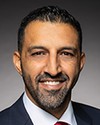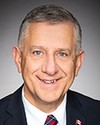Good afternoon. Thank you for the invitation to present to the committee today.
I'm the co-founder and CEO of Greengate Power. Greengate is a renewable energy development company based in Calgary, Alberta, which has been behind some of the largest renewable energy projects in Canadian history.
For background, though, perhaps I could share a bit of my professional story.
I graduated with with a computer science degree from the University of Toronto. I started my career in technology consulting, helping companies apply Internet-based technology to solve business problems.
In my mid-twenties I left consulting to start my own software company, which was an Internet-based software solution for oil and gas. We successfully commercialized the software, and eventually it became an industry-leading solution.
Amongst the many capabilities of the software was helping oil and gas companies track and report their greenhouse gas emissions during a time when greenhouse gas emissions were not nearly the issue that they are today. This gave me early insight into the looming environmental challenges I could see the energy industry facing.
I had a successful exit from that company at the age of 30, and I knew the next business I wanted to start would be something that would leave a lasting positive environmental impact.
With no prior experience in power, I started Greengate with my brother Jordan, with our own capital, more than 17 years ago. The goal was simple: to prove that large-scale renewable energy projects could work in Alberta, the heart of oil country. How hard could that be?
Yet Greengate has successfully developed over $2 billion of operating renewable energy projects in Alberta. representing about one-third of all the renewables in the province today. These projects produce enough energy to power more than half a million homes.
This includes several of the largest wind projects in the country and the largest solar project in Canadian history, a nearly $1-billion project called Travers Solar.
The projects we developed have secured power purchase agreements with Amazon and Microsoft. Multi-billion-dollar data centre investments are now planned in the province, proving that a clean grid and new economic development opportunities go hand in hand.
For the last five years Alberta has been the leading destination for renewables investment in Canada and one of the top such destinations in North America. We have certainly proven what is possible, and demonstrated to the world that Canada can lead in oil and gas and renewables.
Unfortunately, energy in Canada has become highly politicized and polarized, with different political forces taking on high-profile opposing stances. This was recently demonstrated by Alberta's decision to impose a seven-month moratorium on new renewables projects in the province. This sent a profoundly negative signal throughout the industry. It was recently lifted, but the new rules and uncertainty coming out of the moratorium have put the future of the booming renewables industry in the province at risk.
On one side we have the federal government, which is pushing the provinces, including my home province of Alberta, towards a very ambitious target of a net-zero grid by 2035. On the other hand, we have our provincial government, which is pushing back very hard against that target, with the renewables industry caught in the crossfire. We need to be working on solutions that will be providing us with the clean, affordable and reliable energy we need to meet our future needs. The fight does not serve us.
The world is going through an energy transition, moving from molecules to clean electrons as our primary source of energy. However, this transition will take time, and for the time being we need all forms of energy to meet our quickly growing energy demands. The demand for electricity in particular is expected to increase rapidly, not only due to our growing population, but also due to the electrification of transportation and industry, as well as the rising demands from data centres and AI.
As we move towards a net-zero future, it is important to recognize the opportunities and challenges ahead. We have the triangle of clean, affordable and reliable. Given the current state of technology, we can have two out of three corners covered, but having all three corners covered remains elusive.
This is why incentives such as the federal investment tax credit and the smart renewables and electrification pathways program are so vital in ensuring that industry can attract the necessary capital to build up the energy infrastructure of the future. This includes technology such as renewables, energy storage and carbon capture.
Now is the time to move past polarization, take on the challenge and seize the opportunity ahead for all Canadians.
Again, thank you for the invitation. I look forward to a productive discussion.










